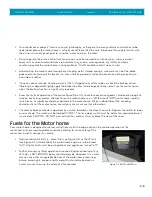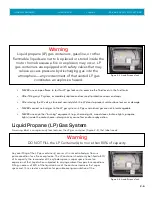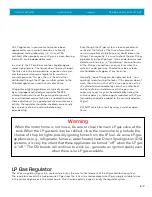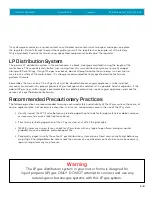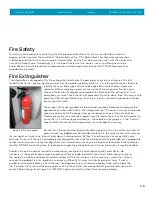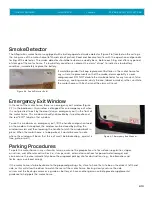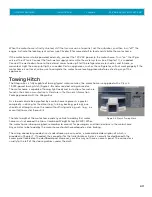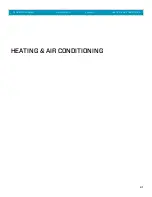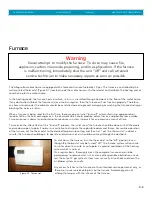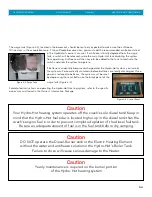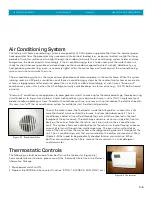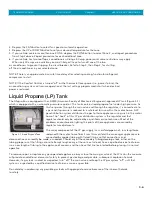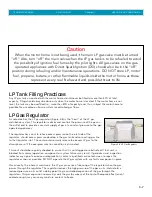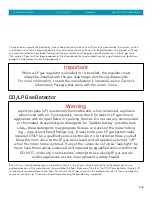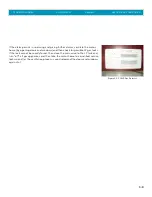
TIFFIN MOTORHOMES
–ALLEGRO BUS®
Chapter 2
DRIVING & SAFETY INSTRUCTIONS
2-5
•
One should never adopt a “learn as you go” philosophy, as there are too many controls and switches to be
understood before the motor home is actually used. Please take the time to become thoroughly familiar with
the entire instrument panel prior to using the motor home on the road.
•
Do not operate the cruise-control function during any extreme weather situations (e.g., snow, ice, sleet,
heavy rain) or when road conditions are hazardous (icy, snowy, winding roads, city traffic) or when a
constant speed of the motor home is not possible or if traffic conditions don’t warrant such.
•
Avoid driving the motor home through any standing water. If deep enough, such water can wet the brake
pads and cause fading of the brakes (i.e., loss of braking power) and lead to excessive sliding or pulling to
one side or another.
•
If one has driven through standing water, at the first opportunity safely to do so, check the braking action.
If braking has degraded, lightly apply the brakes to allow the brake pads to dry—don’t use the motor home
when the braking function is significantly reduced.
•
Know the limits of operation of the motor home. Don’t try to achieve excessive speeds, climb overly steep hills,
traverse overly long grades, attempt to use the motor home as an “off-the-road” (OTR) motor home, rapidly
switch lanes, or rapidly accelerate or decelerate the motor home. When in doubt about the handling
characteristics of the motor home, consult your chassis manual for information.
•
The solar or blackout shade is operated by a switch located on the driver’s console. Depress the switch to lower
or raise shade. The switch will be labeled “VISOR.” The time delay switch must be held a few seconds before it
is activated. CAUTION: DO NOT over extend the shade as this may block the view of the road.
Fuels for the Motor home
Your motor home is designed to use low sulfur fuel only for the engine used in the routine operation of the
motor home—these require prudent and safe handling to assure safety of the
motor home and its occupants; namely:
•
Anytime the motor fuel (i.e., diesel fuel, see Figure 2-2) or the LP tank
(see Figure 2-2) is to be filled, the motor home engine is to be turned
“off,” all pilot lights must be extinguished, and appliances turned “off.”
•
Further, during any filling operation or connecting/disconnecting of any
LP tanks, a NO SMOKING policy should always be observed. In a similar
manner, any other comparable devices of the motor-home users (e.g.,
butane camp-lights, propane lights and grills) should be treated in a
similar manner to assure the safety of all concerned.
Figure 2-2. Fuel Tank Fill Door
Summary of Contents for 2014 Allegro Bus
Page 6: ... TIFFIN MOTORHOMES ALLEGRO BUS Chapter 1 GENERAL INFORMATION GENERAL INFORMATION 1 1 ...
Page 51: ... TIFFIN MOTORHOMES ALLEGRO BUS Chapter 5 CABINETS FURNITURE CABINETS FURNITURE 5 1 ...
Page 55: ... TIFFIN MOTORHOMES ALLEGRO BUS Chapter 6 STRUCTURAL FEATURES STRUCTURAL FEATURES 6 1 ...
Page 57: ... TIFFIN MOTORHOMES ALLEGRO BUS Chapter 7 ELECTRICAL FEATURES ELECTRICAL FEATURES 7 1 ...
Page 72: ... TIFFIN MOTORHOMES ALLEGRO BUS Chapter 8 SLIDE OUT FEATURES SLIDE OUT FEATURES 8 1 ...
Page 76: ... TIFFIN MOTORHOMES ALLEGRO BUS Chapter 9 EXTERIOR FEATURES EXTERIOR FEATURES 9 1 ...
Page 83: ... TIFFIN MOTORHOMES ALLEGRO BUS Chapter 10 INTERIOR FEATURES INTERIOR FEATURES 10 1 ...
Page 87: ... TIFFIN MOTORHOMES ALLEGRO BUS Chapter 11 PLUMBING BATH FIXTURES PLUMBING BATH FIXTURES 11 1 ...
Page 105: ... TIFFIN MOTORHOMES ALLEGRO BUS Chapter 13 ROUTINE MAINTENANCE ROUTINE MAINTENANCE 13 1 ...















